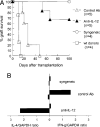On histocompatibility barriers, Th1 to Th2 immune deviation, and the nature of the allograft responses
- PMID: 9725217
- PMCID: PMC3807246
On histocompatibility barriers, Th1 to Th2 immune deviation, and the nature of the allograft responses
Abstract
In the present study, we have sought to determine the basis for the frequent failure of Th1 to Th2 immune deviation to blunt the severity of allograft rejection, as such immune deviation has proven highly effective in the treatment of several T cell-dependent autoimmune states. Our study demonstrates that treating islet allograft recipient mice with anti-IL-12 mAb is highly effective in producing Th1 to Th2 immune deviation in several model systems (i.e., fully MHC, partially MHC, or multiple minor Ag barriers). Nevertheless, anti-IL-12 failed to prolong the engraftment of fully MHC-mismatched islet allografts. However, anti-IL-12-treated recipients carrying MHC-matched but multiple minor Ag-mismatched allografts experienced prolonged engraftment; allograft tolerance was frequently achieved in the DBA/2J (H-2d) to BALB/c (H-2d) strain combination. In another model, in which the host response was dominated by CD4+ T cells responding to donor allopeptides presented upon host APCs in the context of self MHC class II molecules, anti-IL-12 treatment proved to be extremely potent. Thus, Th1 to Th2 immune deviation produces prolonged engraftment as compared with recipients of MHC-mismatched allografts when rejection is dependent upon indirectly presented allogeneic peptides and a reduced mass of responding alloreactive T cells.
Figures





Similar articles
-
Th1 to Th2 immune deviation facilitates, but does not cause, islet allograft tolerance in mice.Cytokine. 2010 Sep;51(3):311-9. doi: 10.1016/j.cyto.2010.06.007. Epub 2010 Jul 2. Cytokine. 2010. PMID: 20598563
-
MHC-mismatched chimerism is required for induction of transplantation tolerance in autoimmune nonobese diabetic recipients.J Immunol. 2014 Aug 15;193(4):2005-15. doi: 10.4049/jimmunol.1401137. Epub 2014 Jul 7. J Immunol. 2014. PMID: 25000982
-
Impact of interleukin-2-expanded regulatory T cells in various allogeneic combinations on mouse skin graft survival.Transplant Proc. 2012 Nov;44(9):2840-4. doi: 10.1016/j.transproceed.2012.09.032. Transplant Proc. 2012. PMID: 23146537
-
Contrasting alloreactive CD4+ and CD8+ T cells: there's more to it than MHC restriction.Am J Transplant. 2003 Feb;3(2):107-15. doi: 10.1034/j.1600-6143.2003.00036.x. Am J Transplant. 2003. PMID: 12603205 Review.
-
How the MHC selects Th1/Th2 immunity.Immunol Today. 1998 Apr;19(4):157-63. doi: 10.1016/s0167-5699(97)01237-1. Immunol Today. 1998. PMID: 9577091 Review.
Cited by
-
The Effects of Tacrolimus on Tissue-Specific, Protein-Level Inflammatory Networks in Vascularized Composite Allotransplantation.Front Immunol. 2021 May 4;12:591154. doi: 10.3389/fimmu.2021.591154. eCollection 2021. Front Immunol. 2021. PMID: 34017323 Free PMC article.
-
Regulation of T cell dependent immune responses by TIM family members.Philos Trans R Soc Lond B Biol Sci. 2005 Sep 29;360(1461):1681-5. doi: 10.1098/rstb.2005.1706. Philos Trans R Soc Lond B Biol Sci. 2005. PMID: 16147532 Free PMC article. Review.
-
Regulation of T-cell immunity by T-cell immunoglobulin and mucin domain proteins.Transplantation. 2007 Jul 15;84(1 Suppl):S12-6. doi: 10.1097/01.tp.0000269111.87719.d8. Transplantation. 2007. PMID: 17632405 Free PMC article.
-
Is transplantation tolerable?J Clin Invest. 2004 Jun;113(12):1681-3. doi: 10.1172/JCI22153. J Clin Invest. 2004. PMID: 15199402 Free PMC article.
-
Low-dose lymphocyte immunotherapy rebalances the peripheral blood Th1/Th2/Treg paradigm in patients with unexplained recurrent miscarriage.Reprod Biol Endocrinol. 2017 Dec 16;15(1):95. doi: 10.1186/s12958-017-0315-9. Reprod Biol Endocrinol. 2017. PMID: 29246150 Free PMC article.
References
-
- Mosmann TR, Coffman RL. Th1 and Th2 cells: different patterns of lymphokine secretion lead to different functional properties. Annu. Rev. Immunol. 1989;7:145. - PubMed
-
- Trinchieri G. IL-12, a proinflammatory cytokine with immunoregulatory functions that bridge innate resistance and antigen-specific adaptive immunity. Annu. Rev. Immunol. 1995;13:251. - PubMed
-
- Magram J, Connaughton SE, Warrier RR, Carvajal DM, Wu C, Ferrante J, Stewart C, Sarmiento U, Faherty DA, Gately MK. IL-12-deficient mice are defective in IFN-γ production and type 1 cytokine responses. Immunity. 1996;4:471. - PubMed
-
- Wu C, Ferrante J, Gately MK, Magram J. Characterization of IL-12 receptor β1-chain-deficient mice: IL-12 receptor β1 is an essential component of the functional mouse IL-12 receptor. J. Immunol. 1997;159:1658. - PubMed
-
- Kaplan MH, Sun YL, Hoey T, Grusby MJ. Impaired IL-12 responses and enhanced development of Th2 cells in Stat4-deficient mice. Nature. 1996;382:174. - PubMed
Publication types
MeSH terms
Substances
Grants and funding
LinkOut - more resources
Full Text Sources
Other Literature Sources
Medical
Research Materials
Miscellaneous
